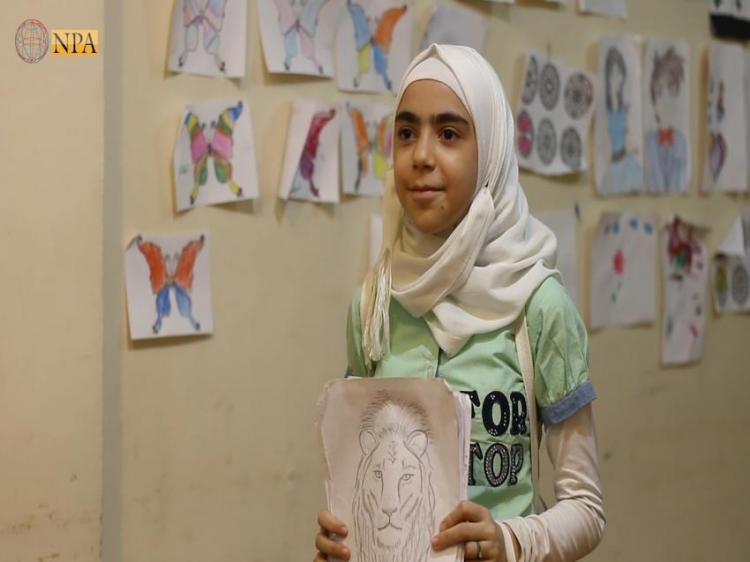North-Press Agency
Cairo – Muhammad Abo Zayd
The ongoing war in Syria forced many families for emigration and displacement, as children are the most influenced by their families’ circumstances, where different environment, place, friends and integration attempts into new societies promoted Malak, a little child, to complete her life by her quill, and with a great skill drawing war remnants with the colors of nature.
The story of Malak
Malak Rabea, Syrian child 13 years old talks to North-press about drawing, a talent she acquired in Syria then polished it in Egypt as her parents, teachers, educational center and even her relatives encouraged and supported her to develop, “I spend hours in one drawing and sometimes I spend a full day in concentrating, if I don’t like it, I tear it and draw another one until it comes out in its final shape that satisfies me, I adore drawing nature, animals, trees, flowers, and heaven”, Malak said.
The Syrian girl came to Egypt six years ago with her family fleeing the devastating war in her country, she found out that drawing was her target, she worked on embodying landscapes on paper, by which she escapes from war ghosts that still haunt her, she says that she insists on drawing nature, the one that she saw in Syria before leaving, on the contrary of devastation and destruction scenes she sees it now through the media.
Drawing and music
“Drawing and music are a cornerstone of psychological rehabilitation of Syrian children, we are keen to have a constant interest in these arts and encourage children and students in the center, holding competitions from time to time to motivate them, as well as other sports activities” Noura Ali, director of one of the Syrian Center for refugees children education told North-Press.
According to Noura, such activities “represent strong psychosocial support for children, making them express their energies in a useful and productive way, they reveal their dreams, ambitions, and vision of war by drawing, expressing their feelings through drawing, this is what Syrian specialized centers are keen on as well as providing a standard curriculum for students.”
Malak considers drawing her main gate to overcome the reality that doesn’t inspire much optimism and cling to a future that is as dazzling as the flowers she draws, She says that she draws the future she dreams of, so one cannot find in her childish drawings, as many of her mates, ones of war, because her drawings reflect nature and future, expressing Malak’s dream of going back to Syria where she first opened her eyes in.
Malak is now in the eighth grade in an Egyptian school, she is supported by one of the educational centers in order to polish her talent and in order to help her in the curriculum, she studies along with other colleagues’ refugees.
Her talent grabbed her teachers and surroundings’ attention, and they started encouraging her and her colleagues to draw, in support of their talent as well as a means of psychological support for refugees’ children.
Psychological support
“The concept of drawing therapy as one of key concepts in the psychological support for children through drawing, as it is a part of art therapy concept in general, which supports children to express their feelings, what is going on with them, and their perception of all situations, it’s an important tool for psychological support of children in countries experiencing internal crises or wars that have direct impact on children in particular, especially that refugee children suffer from psychological problems”, Egyptian psychological consultant Dr. Iman Al-Batran, said to North-Press.
“Drawing can also be used as a means of integrating refugee children into their new communities by engaging them in competitions with other children from the hosting country, encouraging and motivating them to draw and express the nature around them, and awarding the distinguished ones of them”, Al-Batran added.
According to Dr. Al-Batran, art therapy, in general, has been known for hundreds of years and dates back to the 18th century.
Furthermore, there are many projects provided by institutions and organizations in support of refugee children, focusing mainly on child psychotherapy and support, in which “drawing” is strongly present as one of the most important treatment tools, such as psychotherapy projects for Syrian children in Syria, Lebanon, Jordan and Turkey provided by institutions concerned in relying on drawing and shaping as one of their tools. Those institutions recognized the importance of art as a means of psychological treatment for children whose countries suffer from the scourge of war and internal crises.

